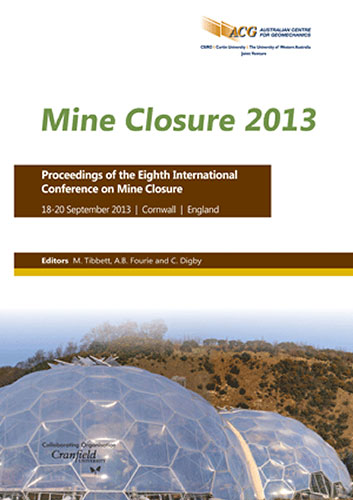Mine closure: merging multiple discourses

|
Authors: Van Vlaenderen, H; Guicherit, H; Hendrik, F; Watt, C; Stewart, W; Nandlal, A; George, J Paper is not available for download Contact Us |
DOI https://doi.org/10.36487/ACG_rep/1352_40_Van_Vlaenderen
Cite As:
Van Vlaenderen, H, Guicherit, H, Hendrik, F, Watt, C, Stewart, W, Nandlal, A & George, J 2013, 'Mine closure: merging multiple discourses', in M Tibbett, AB Fourie & C Digby (eds), Mine Closure 2013: Proceedings of the Eighth International Seminar on Mine Closure, Australian Centre for Geomechanics, Cornwall, pp. 473-482, https://doi.org/10.36487/ACG_rep/1352_40_Van_Vlaenderen
Abstract:
The IFC Performance Standards on Social and Environmental Sustainability (2006, updated 2012) are generally regarded as the international benchmarks for developing and financing responsible extractive projects in emerging markets. Included in these Performance Standards is the obligation for post-closure rehabilitation of areas disturbed by mining projects. Key to effective closure planning is stakeholder engagement. This paper presents a case study of stakeholder engagement in a land reclamation planning process in a rural area in the Marowijne District in Suriname. The case study is based on a project executed by SRK Consulting on behalf of Suralco L.L.C. (a subsidiary of Alcoa Inc.). The project includes the preparation of a Framework for an Integrated Closure Plan for all of Suralco’s landholdings and mining concessions, located principally in the Commewijne, Marowijne and Para Districts of Suriname. The stakeholder engagement process is discussed in terms of its influence on the closure plan. To elucidate the process, an activity theory approach is adopted. Activity theorists regard activity (e.g., the land rehabilitation process) as ‘a purposeful process in which subjects (i.e., stakeholders) are connected to an object (land use) through culturally constituted mediational means (public meetings, soil analysis tests, etc.)’. The paper sets out how the integrated closure process is differently approached by the various stakeholders, each using different and potentially conflicting discourses. The tensions arising in the process are analysed in terms of their role in the development of viable and appropriate future land uses, which then will factor into the ultimate closure plan. It is concluded that the effectiveness of stakeholder involvement in the closure planning process depends on a thorough understanding of the historical-cultural background of the stakeholders and their interactions as well as the careful management of the tensions that arise during the stakeholder engagement process in terms of objectives and methods used.
References:
Engeström, Y. (1987) Learning by Expanding: An Activity-Theoretical Approach to Developmental Research, Orienta-Konsultit, Helsinki.
Engeström, Y. (1989) Activity theory and the study of political repression, International Journal of Mental Health, Vol. 17(4),
pp. 29–41.
© Copyright 2025, Australian Centre for Geomechanics (ACG), The University of Western Australia. All rights reserved.
View copyright/legal information
Please direct any queries or error reports to repository-acg@uwa.edu.au
View copyright/legal information
Please direct any queries or error reports to repository-acg@uwa.edu.au